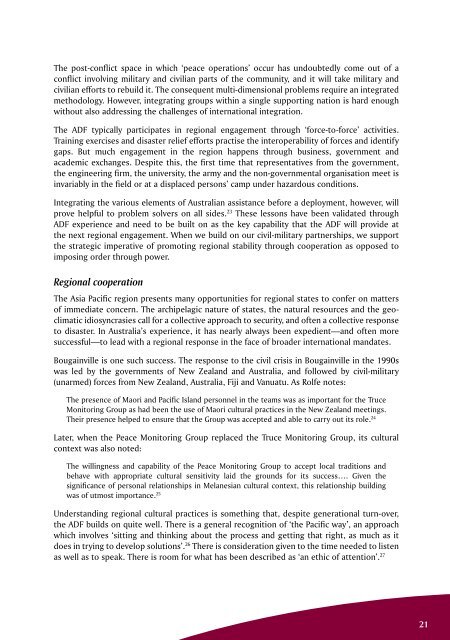ISSUE 191 : Jul/Aug - 2013 - Australian Defence Force Journal
ISSUE 191 : Jul/Aug - 2013 - Australian Defence Force Journal
ISSUE 191 : Jul/Aug - 2013 - Australian Defence Force Journal
- No tags were found...
You also want an ePaper? Increase the reach of your titles
YUMPU automatically turns print PDFs into web optimized ePapers that Google loves.
The post-conflict space in which ‘peace operations’ occur has undoubtedly come out of a<br />
conflict involving military and civilian parts of the community, and it will take military and<br />
civilian efforts to rebuild it. The consequent multi-dimensional problems require an integrated<br />
methodology. However, integrating groups within a single supporting nation is hard enough<br />
without also addressing the challenges of international integration.<br />
The ADF typically participates in regional engagement through ‘force-to-force’ activities.<br />
Training exercises and disaster relief efforts practise the interoperability of forces and identify<br />
gaps. But much engagement in the region happens through business, government and<br />
academic exchanges. Despite this, the first time that representatives from the government,<br />
the engineering firm, the university, the army and the non-governmental organisation meet is<br />
invariably in the field or at a displaced persons’ camp under hazardous conditions.<br />
Integrating the various elements of <strong>Australian</strong> assistance before a deployment, however, will<br />
prove helpful to problem solvers on all sides. 23 These lessons have been validated through<br />
ADF experience and need to be built on as the key capability that the ADF will provide at<br />
the next regional engagement. When we build on our civil-military partnerships, we support<br />
the strategic imperative of promoting regional stability through cooperation as opposed to<br />
imposing order through power.<br />
Regional cooperation<br />
The Asia Pacific region presents many opportunities for regional states to confer on matters<br />
of immediate concern. The archipelagic nature of states, the natural resources and the geoclimatic<br />
idiosyncrasies call for a collective approach to security, and often a collective response<br />
to disaster. In Australia’s experience, it has nearly always been expedient—and often more<br />
successful—to lead with a regional response in the face of broader international mandates.<br />
Bougainville is one such success. The response to the civil crisis in Bougainville in the 1990s<br />
was led by the governments of New Zealand and Australia, and followed by civil-military<br />
(unarmed) forces from New Zealand, Australia, Fiji and Vanuatu. As Rolfe notes:<br />
The presence of Maori and Pacific Island personnel in the teams was as important for the Truce<br />
Monitoring Group as had been the use of Maori cultural practices in the New Zealand meetings.<br />
Their presence helped to ensure that the Group was accepted and able to carry out its role. 24<br />
Later, when the Peace Monitoring Group replaced the Truce Monitoring Group, its cultural<br />
context was also noted:<br />
The willingness and capability of the Peace Monitoring Group to accept local traditions and<br />
behave with appropriate cultural sensitivity laid the grounds for its success…. Given the<br />
significance of personal relationships in Melanesian cultural context, this relationship building<br />
was of utmost importance. 25<br />
Understanding regional cultural practices is something that, despite generational turn-over,<br />
the ADF builds on quite well. There is a general recognition of ‘the Pacific way’, an approach<br />
which involves ‘sitting and thinking about the process and getting that right, as much as it<br />
does in trying to develop solutions’. 26 There is consideration given to the time needed to listen<br />
as well as to speak. There is room for what has been described as ‘an ethic of attention’. 27<br />
21

















